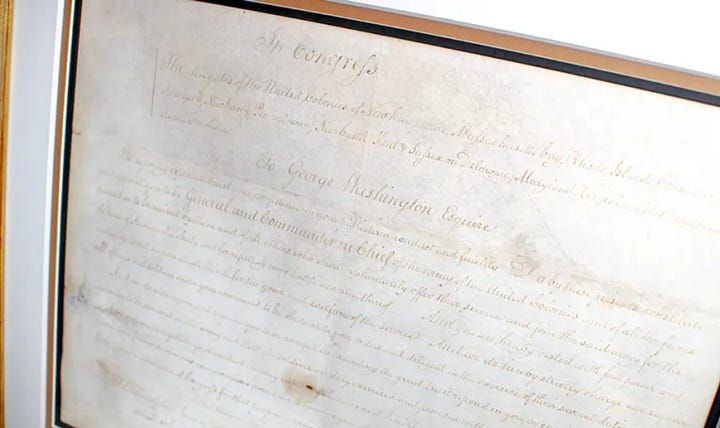Rediscovered Mozart. Oldest Hebrew book.
Plus, an upcoming C.S. Lewis lecture, reading charred scrolls, and targeting Nazareth
Let’s meet for coffee this Friday, September 27, at 6:30 am at Loyal North.
Last week I was in Palm Beach and had the privilege of visiting Raptis Rare Books. Its beautiful gallery space is filled with books—rare, signed, some beautifully rebound—tucked into floor-to-ceiling walnut shelves and cabinets. One of the most expensive items on offer is a first-edition Hobbit inscribed by the author, priced at $475,000. For more than double that price, you can own an original (one of only two) of George Washington’s 1775 commission from the Continental Congress appointing him Commander in Chief of the United Colonies.


My ambitions were far more modest. I purchased a 35th anniversary edition of Norman Juster’s The Phantom Tollbooth, original dust jacket, inscribed by the author. It’s one of the cleverest children’s stories you’ll ever read and equally entertaining for adults.
In the spirit of my rare book digression comes this week’s Two Things.
(1) Smells Like Teen Mozart
The Strad reports that a string trio dated to Mozart’s early teenage years has been rediscovered in a library in Leipzig, Germany:
A previously unknown string trio from Mozart’s early years has been discovered in the archives of the music library of the Leipzig Municipal Libraries, according to a statement from the institution, one of the largest public music libraries in Germany.
Consisting of seven miniature movements for two violins and bass (including two minuets) and lasting a total of some twelve minutes, the C major trio ‘is thought to have been written in the mid to late 1760s’, the researchers posit – likely during the composer’s earliest teenage years and pre-dating his first visit to Italy in 1769….
The source was evidently Mozart’s sister, and so it is tempting to think that she preserved the work as a memento of her brother. Perhaps he wrote the Trio specially for her….
(Thanks to Brad Hale for the pointer to this story.) The Strad goes on to report that the musical piece, which has been named Ganz kleine Nachtmusik, “received its much-belated modern premiere on 19 September 2024 in Mozart’s native Salzburg.” This was followed “by the German premiere at Leipzig Opera on 21 September, with Vincent and David Geer playing the violin parts and Elisabeth Zimmermann on cello.” Watch it here and listen to the end, where the piece becomes even more lively and light-hearted:
(2) Most ancient Hebrew book, discovered in Afghan cave
The Free Press has this one:
In 2019 a curator from the Museum of the Bible in Washington, D.C., and an elderly scholar from Jerusalem were at work on an odd manuscript: a pocket-sized Hebrew book of uncertain age and origin….
Some of the pages contained a previously unknown poem for the Jewish festival of Sukkot. On one page, an untrained scribe, perhaps a child practicing lessons, wrote out the Hebrew alphabet. Other pages had a version of the Haggadah, the text read by Jewish families at the festive Passover meal.
The Jerusalem scholar, Malachi Beit-Arié, had a hunch that the book’s story was other, and older, than it seemed…. When the radiometric results finally came back from the lab, they proved him right: The parchment dated to between 660 and 780 CE. This result didn’t mean a minor chronological adjustment. It meant that the mysterious little book had just been catapulted into a different league of antiquities.
The new date meant that the text of the Passover Haggadah wasn’t just ancient—it was the most ancient known to scholars. The book predated the first standardized Jewish siddur, or prayer book, by more than a century. The research team was holding, in fact, the oldest bound Hebrew book ever discovered.
Just as remarkable as the age of the codex is where it was found:
The book’s true place of origin, it seemed, was not Cairo, or Babylon, as some scholars thought, but Bamiyan, in the Hindu Kush 80 miles northwest of Kabul.
Bamiyan served for centuries as a stop along the great east-west trading routes known collectively as the Silk Road, and unlikely as this may seem now, Jews once lived here as a minority, not among Muslims but among Buddhists. At the same time the book was made by artisans cutting, folding, and binding animal skins in the 700s CE, Islam was surging across the region from Arabia, but had yet to conquer these mountains.
It goes on display, starting tomorrow, at the Museum of the Bible.
Other Things
Mark your calendars for Wednesday, October 30, at 6:00 p.m., when Dr. Brad Hale delivers a lecture on C.S. Lewis as part of a First Pres lecture series.
Scholars continue to “virtually unwrap” ancient scrolls using X-ray tomography and computer vision. A trove of charred scrolls at Herculaneum (near Pompei) is a gold mine.
Hezbollah has begun targeting Nazareth and Galilee, “threatening countless holy places.” Cue the Christian condemnations? Not so much. Leftist Anglican clerics still think the problem is … (do I need to complete this sentence?).
Hope to see you Friday.

